 |

| |
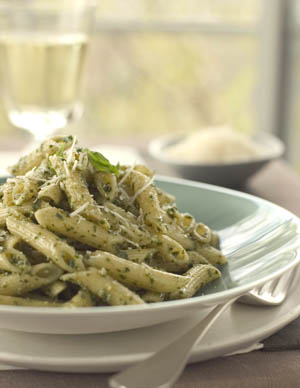
Pesto made with pignoli nuts and olive oil is a classic. But you can make a walnut or hazelnut pesto by switching the nuts and the oils to La Tourangelle Walnut Oil or Hazelnut Oil, and have your taste buds dance a different jig. Click here for the recipe. |
| WHAT IT IS: Artisan nut oils. |
| WHY IT’S DIFFERENT: Virgin oil pressed from the best nuts from California and France. |
| WHY WE LOVE IT: Centuries-old artisan techniques, including the delicate craft of roasting the nuts prior to pressing, result in heavenly flavors and aromas. |
| WHERE TO BUY IT: LaTourangelle.com |
|
|
 |

La Tourangelle:
Nuts About Oil
If you have not yet discovered nut oils, get ready for another culinary epiphany. If you’ve only used them to dress salads, ditto. Nut oils have long been the domain of the French, who have preserved the ancient craft of squeezing nuts for oil. Fine artisan nut oils bear little resemblance in flavor to the oils of identical name that can be found in health food stores; French nut oils are an affordable luxury, and a little goes a long way.
La Tourangelle is the California venture of a venerable French huilerie. The California oils are made in the French tradition, supervised by a son of a family that still makes oils in the Loire Valley. While La Tourangelle’s Roasted Walnut Oil has won numerous accolades (and is certified kosher, along with the Almond, and soon, Pecan and Pistachio Oils), our favorites were the Almond, Hazelnut and Sesame. We refilled our liqueur cups to drink extra servings, that’s how good they were (and how our tastings work: first taste plain, then with food). All of the oils are elegant and worth getting to know: Below, we’ve detailed the many ways you can get to know them. Beyond vibrant vinaigrettes, they make rich risottos, passionate pestos, and frisky finishing oils that have delighted French chefs for centuries.
- To read the full review below, click here. If your e-mail client does not support anchor links that jump to text above or below, e.g. AOL, please scroll down.
- Read reviews of more of our favorite oils.
- Review the Table of Contents of the January issue of THE NIBBLE™ online magazine, plus the back issues archive and our most popular articles.
- All of the Top Pick Of The Week newsletters are permanently archived on TheNibble.com, in chronological order and by product category.
|
Learn More About Gourmet Oils
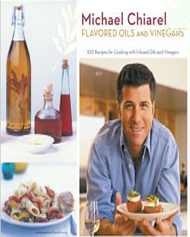 |
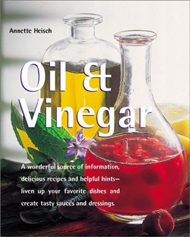 |
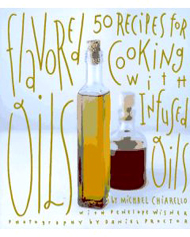 |
| Michael Chiarello’s Flavored Oils & Vinegars: 100 Recipes for Cooking With Infused Oils & Vinegars, by Michael Chiarello. The Food Network chef shares 100 creative recipes for both making and using flavored oils and vinegars that capture the essence of herbs, fruits, vegetables and spices. Sure to dazzle any dish. Click here for more information or to purchase. |
Oil & Vinegar, by Annette Heisch. This comprehensive guide to oils and vinegars starts at the beginning, with their origins and levels of quality, and how to shop for and store oils and vinegars. Along with many innovative recipes, Heisch shares the art of creating one’s own gourmet vinegars and oils. Click here for more information or to purchase. |
Flavored Oils: 50 Recipes For Cooking With Infused Oils, by Michael Chiarello with Penelope Wisner. The owner/chef of Napa Valley’s Tra Vigne restaurant shares his wisdom for jazzing up ordinary dishes with flavored oils. His detailed advice on judicious use of them includes instructions for infusions that are easy-to-follow. Click here for more information or to purchase. |
La Tourangelle Artisan Nut Oils: Nuts About Oil
While people the world over have pressed their local nut crops to make culinary oil, fine nut oils are a French tradition and the world’s great nut oils come from France. In older days, each town would have a mill that roasted and pressed the oil from nuts gathered by local farmers, similar to a grist mill to grind grain into flour. While grist mills have gone the way of industry, today a few artisan oil mills remain in France, one of the oldest and most respected of which is Les Huileries de la Croix Verte et La Tourangelle, a merger of two venerable companies, Les Huileries de la Croix Vert (The Green Cross Oil Works) and La Tourangelle (The Woman of The Touraine, a former province of west-central France, the capital of which was Tours). Based near the picturesque Loire Valley town of Saumur, the huilerie, now owned by the Kohlmeyer family, continues to produce the finest nut oils using time-honed artisan techniques. Little has changed since La Tourangelle was established in the mid-1800s—except, of course, electricity means that the mill is no longer powered by oxen.
As some of France’s finest vintners sought business opportunities in the glorious agricultural terrain that is California—Moët-Hennessy, one of the first, established Domaine Chandon in the Napa Valley—Les Huileries de la Croix Verte et La Tourangelle developed a partnership with California Oils Corp., a trading partner that owned an oil mill in Woodland, California, northeast of Napa. Thus was born the American firm, La Tourangelle, Inc. Matthieu Kohlmeyer moved to California to recreate his family’s French artisan oil business, custom-making replicates of the century-old equipment and bringing an oil-roasting artisan from France to train the American crew. Woodland is a Gold Rush town, founded in 1861—around the same year that Monsieurs Morillon and Bechet founded La Tourangelle in Saumur.
Using California’s bountiful almond, pecan, pistachio and walnut crops, oils are made at the mill. Hazelnut oil is imported from the family’s French mill, grapeseed oil from Chile (large wine-producing countries are major producers of fine grapeseed oil—Italy is another major producer) and sesame oil from a fine artisan mill in Japan.
Making The Oils
It all begins with the finest nuts, which are harvested in the fall by local farmers. The best of the crop are selected, dried naturally in the sun to preserve their natural flavors, hand-roasted in cast iron pots, cold-pressed and lightly filtered.
In addition to starting with the best-quality nuts, roasting is key to producing a fine oil. It is the skill of the roaster that heightens the walnut flavor in the oil—think of the difference in taste between plain and toasted walnuts. The cast iron pots used to roast the nuts come from the mill in France, and they are equally essential to achieve the right flavor.
After roasting, the nuts are pressed using only expeller pressing* to extract the oil (this is similar to the way extra virgin olive oil is pressed). The resulting oil is lightly filtered to remove particles; there is no further processing. |
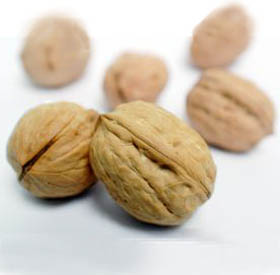 Walnuts used in the Roasted Walnut Oil are grown in the orchard next door to the mill.
Walnuts used in the Roasted Walnut Oil are grown in the orchard next door to the mill. |
There are many nut oils available, including those at health food stores, that appear to be much more affordable. These can be refined or commercial oils that have nothing in common with a fine artisan oil like La Tourangelle, except that they are made from the same species of nut. They don’t start with a painstaking selection of the finest nuts from the orchard, then patient sun-drying; they don’t roast the nuts to bring out the flavor, and/or they don’t use mechanical (expeller) pressing. Heat and chemical pressing are much faster—that’s why the oils are so much less expensive. Mechanical pressing retains the maximum nutritional as well as the flavor components.
*Oils that are cold-pressed are expeller-pressed. This is a chemical-free mechanical process that extracts oil from seeds and nuts. There is no external heat applied. The temperature reached during pressing depends on the hardness of the nut or seed: The harder the nut or seed, the more pressure is required to extract the oil, which in turn creates more friction and higher heat. The oils are pressed in a heat-controlled environment to keep temperatures below 120°F. By comparison, many commercial oils use the hexane-extraction method, which employs chemicals. Delicate oils, or those in which flavor nuances are a key component, need to be treated with greater care in controlling processing factors. It is important to note that while Europe has rigorous standards for the terminology of “cold pressing,” which must take place at temperatures below 122°F, the phrase standard does not exist in the U.S. and is often employed for oils which have been expeller-pressed or even refined. This exposes the oil to temperatures of up to 470° F, with a loss of both flavor and nutrients. For more information, visit Spectrumorganics.com.
General Serving Suggestions
The French use their nut oil heritage for vinaigrettes, baking and to season and finish vegetable, fish, poultry and even fruit dishes. While the French have a reputation for cooking with butter and cream, gourmands-in-general as well as those who seek alternatives to cholesterol relish the rich flavors of nut oils. Just as each type of nut has its own unique flavor, so do these elegant artisan oils. From their roots in the countryside, nut oils have been used in rustic cooking and as treasured ingredients by the great chefs of Paris.
Each of the nut oils, and the sesame oil, can be used in the following ways:
- Vinaigrettes: As a lovely change of flavor.
- Bread dipper: Use nut oils instead of olive oil.
- Cheese condiment: With tangy cheeses like goat, feta and Castelmagno† or with dry and crumbly cheeses, each of the nut oils brought out taste nuances in that made the cheeses—tasty to begin with—much more exciting. Drizzle oil over the whole cheese, or allow diners to pour the oil over their individual portions.
- Compound butter: To flavor butter, soften and mix with several tablespoons of oil to taste.
- Instead of butter or olive oil: With rice and pasta.
- In soups and sauces: Use instead of olive or vegetable oils to add extra flavor.
- Finishing oil: Drizzle on fish, fowl, meats or vegetables.
- Baking: A cholesterol-free butter substitute, the nut oils provide a rich and delicious flavor.
- Ice cream: Substitute for olive oil in a recipe for olive oil ice cream.
†A splendid cheese from the Piedmont region of Italy, made in a number of town districts in the province of Cuneo. It is made from cow’s milk, though sheep’s or goat’s milk may be added, to create a cylindrical pressed, semi-fat, semi-hard cheese tinged with blue mold. It has been made since the 12th century, about the same time as Gorgonzola. Well worth seeking out!
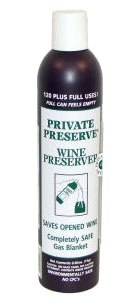 In addition to these common applications, we’ve singled out special uses for each oil below. In addition to these common applications, we’ve singled out special uses for each oil below.
Cooking With Nut Oils. Three of the oils—Almond, Hazelnut and Walnut—have medium-high smoke points and can be used to sauté. Pistachio and Pecan Oils have lower smoke points and need to be confined to the purposes above. Sesame Oil has a lower smoke point but can be used for quick stir-fry cooking.
Preserving Your Oils. After the can is opened, the oils must go into the refrigerator to keep fresh—ideally with a short burst of a wine preservative spray‡ to prevent oxidation. If you need to keep the oils at room temperature, the preservative spray is a must, or the oils will have a very short shelf life (use the spray for all fine oils that you don’t use up quickly).
‡A mixture of Nitrogen, Argon and CO2: Use it to preserve your oils as well as your wines. Simply spray a short burst into the neck of an opened bottle of wine to prevent oxidation and increase longevity and freshness. Click here for more information or to purchase.
Individual Oils & Uses
Up-front, we’ll state that our group of tasters unilaterally agreed on favorites Almond, Sesame and Hazelnut. Almond was one of the more delicate oils, Sesame the most powerful, Hazelnut in the middle. We tasted them against other excellent brands of the same nut’s oil—ones we had in our own pantry—and found them to be superior. We were surprised: Based on all of the press it has received, we had expected to pick the Walnut as our first choice, and since pistachio is our favorite nut, we were expecting to favor that oil as well. But read our tasting notes, and you’ll see why we chose what we did. We wouldn’t hesitate to use any of the oils, however: All are very high quality and superbly made. They are presented here in alphabetical order.

Almond oil brings out new flavors in traditional hummos. Almond oil replaces the olive oil, and some almonds are added as well.
See the complete Almond Hummos recipe.
|
Roasted Almond Oil. Produced in the California mill in very small batches, the Roasted Almond Oil has a remarkable flavor of exactly what the label says: roasted almonds. Of all the oils tasted, this is the one where we felt we were eating a liquid version of the nut itself—a gossamer version. We are not exaggerating when we say that all of the tasters poured themselves two or three extra liqueur-size glasses and drank this oil as a nectar. Certified Kosher.
- For a vinaigrette, mix 4 tablespoons Roasted Almond Oil, 1 tablespoon sherry vinegar and salt and pepper to taste.
- Think of Roasted Almond Oil as a finishing oil for Trout Amandine or any fish done in the same manner.
- It has a medium-high smoke-point, so you can use it to sauté any food—especially one with an almond crust.
- Use it to dress a cold string bean salad with roasted, sliced almonds.
- Use it to moisten any dish with that also contains almonds: couscous, rice or stuffing, for example.
|
Roasted Hazelnut Oil. Produced in Saumur, France by Les Huileries de la Croix Verte et La Tourangelle, with hazelnuts harvested in western France, this oil has a nose that is a bit smoky and very alluring. The flavor is much more subtle—unlike the Roasted Almond Oil, we were not drinking liquid hazelnut but a hazelnut-infused oil. Yet, it is a beautiful oil, and our third favorite in this tasting. It is best when drizzled on salads, baked into cakes or as a bread dipper.
- For a vinaigrette, mix 4 tablespoons Roasted Hazelnut Oil, 1 tablespoon balsamic vinegar and salt and pepper to taste. For a more complex dressing, look at the delicious Hazelnut Citrus Vinaigrette.
- A great pesto oil: instead of the traditional pignoli nuts and olive oil, make a French pesto with hazelnuts and hazelnut oil (see our article on pestos, including a classic pesto recipe).
- The great French chef Michel Bras makes a salad of Jerusalem artichokes (sunchokes): cook for 10 minutes in salted white wine; drain, slice, season with lemon juice, hazelnut oil and Dijon mustard (add chopped toasted hazelnuts if desired).
|
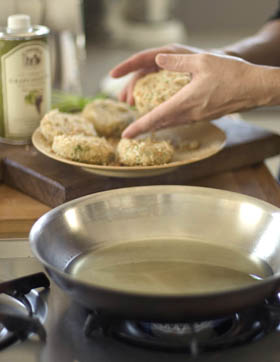 Hazelnut oil has a medium-high smoke point, so it can be used to sauté. For frying, La Tourangelle sells a gourmet grapeseed oil—a chef’s favorite for high-heat cooking, with one of the highest smoke points.
Hazelnut oil has a medium-high smoke point, so it can be used to sauté. For frying, La Tourangelle sells a gourmet grapeseed oil—a chef’s favorite for high-heat cooking, with one of the highest smoke points. |
- La Tourangelle offers its own Jerusalem artichoke salad with oyster mushrooms—click here for the recipe.
Hazelnut oil has 10.9g of omega-9 fatty acids per tablespoon.
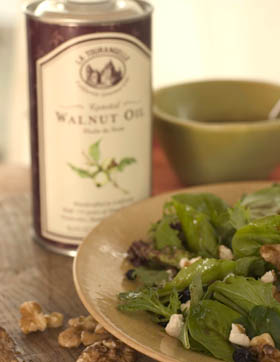
|
Roasted Pecan Oil. Made from California-grown pecans, this oil is toasty and nutty but not immediately identifiable as pecan. Yet, with its medium smoke point, it enabled us to experiment. Kosher certification pending.
- Pecan oil made delicious sautéed scallops.
- We also enjoyed the flavors it brought to rabbit sausage, and we used it to quickly cook a delicate loin of rabbit.
- We made it into a compound butter and used it with smoked salmon tea sandwiches.
- We look forward to baking with it as well.
One bite and people will go nuts over this salad. Pair a vinaigrette of pecan or walnut oil with toasted nut and goat cheese or Roquefort. Add-ons include sliced pear or apple.
|
Roasted Pistachio Oil. Pistachio is our favorite nut, and we have tried several pistachio oils. While we personally favor ones that are more intensely pistachio than this subtle and elegant version made from California pistachios (this was the most quietly-flavored of the La Tourangelle oils), others may prefer the lighter touch. Kosher certification pending.
- Candy makers who make nougatine will find this perfect for oiling the work surface (more so than the heavier-tasting pistachio oils).
- Breads and cakes that call for pistachios will pick up extra touches of flavor by substituting a portion of the butter for the oil.
- We made a tasty goat cheese and chopped pistachio bruschetta, brushing the bread with the Roasted Pistachio Oil.
- It is a lovely finishing oil for any game bird.
- The flavor complements crab beautifully, and can be blended into a crab risotto.
|
|
Roasted Walnut Oil. In 2005, in a blind tasting among Bay Area chefs, La Tourangelle Roasted Walnut Oil was the winner in the San Francisco Chronicle’s Taster’s Choice Awards, with a high score that put it into the competition’s Hall of Fame. The following year, it was a finalist in the Outstanding Oil, Vinegar or Salad Dressing category at the annual National Association for the Specialty Food Trade (NASFT) Awards. It was the first oil produced at the mill in California, and the one that gets the most press. Certified kosher by Star-K.
We love walnut oil, and this one is elegant and delicious. But we have been using walnut oil for so long, we prefer a French oil brand that has a heavier weight and a more pervasive walnut flavor. (It may be the difference in the species of walnuts.) Still, we put this to excellent use:
- A good general vinaigrette proportion is 4 tablespoons oil, 1 tablespoons balsamic vinegar and 1 teaspoon Dijon mustard, with a dash of salt.
|
 Use walnut oil to make this delicious carrot cake: It enhances the flavor of the walnuts in the recipe.
Use walnut oil to make this delicious carrot cake: It enhances the flavor of the walnuts in the recipe.
See the Carrot Cake recipe.
|
Salads to try:
- Our favorite salad: frisée, goat cheese, sliced pears and toasted walnuts, with a walnut vinaigrette.
- Arugula, romaine, blue cheese and walnut salad.
- String beans Provençal salad, with steamed string beans, red onion, anchovy and hard-boiled egg slices.
- Shrimp salad with whole grilled (or boiled) shrimp, snipped chives and minced parsley on butter lettuce.
Beyond salads:
- With its medium-high smoke point, Roasted Walnut Oil adds delicious flavor to sautéed watercress, spinach or other greens.
- After roasting chicken or rabbit, brush with walnut oil as a finishing oil.
- The flavor of walnut oil pairs beautifully with Vitello Tonnato, roast veal in a tuna sauce, one of the original “surf and turf” dishes (substitute walnut oil for the olive oil in the sauce).
Walnuts have a high level of omega-3 fatty acids—the highest level of all nuts, 1.77g per tablespoon—another reason to integrate this tasty oil into your diet.
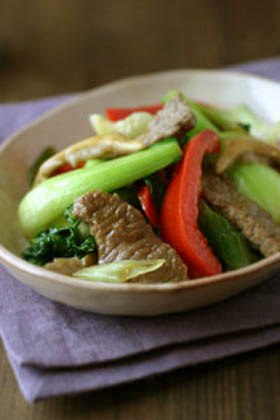
While Sesame Oil has a low-medium smoke point, it can be used in quickly-cooked dishes like stir-frys. A
fine sesame oil like La Tourangelle will make an everyday stir-fry taste much more special. Photo courtesy of UmamiInfo.com.
|
Toasted Sesame Oil. Sesame is a seed, not a nut. But a nut by any other name would taste as sweet, and we are in love with this beautiful oil, handcrafted in Japan at a 270-year-old mill. If your only acquaintance with sesame oil is the dense and heavy kind that is so strong it needs to be diluted with vegetable oil, you will be doubly astounded by the artisanship of this divinely drinkable, impeccably balanced oil. Notes of toast, butter and sesame combine into something so delicious, we commented, quite seriously, that cutting-edge restaurants should be serving flights of fine oils in shot glasses for their clientele to taste, as we did.
- As “gourmet” as this oil is, it was the only one of the oils with enough heft to flavor mashed potatoes.
- Add some to a beef marinade for delicious results.
- In a tuna tartare, or any raw fish preparation, it is heaven.
- Stir in to cooked orzo and add peas for a delicious side; or add to rice with minced scallions and toasted sesame seeds.
- For a wonderful vinaigrette, mix 4 tablespoons sesame oil with 1 tablespoon rice vinegar, 1 teaspoon Dijon mustard and 1/2 teaspoon grated fresh ginger (optional); salt and pepper to taste.
|
Grapeseed Oil. Like Toasted Sesame Oil, La Tourangelle’s Grapeseed Oil is not a nut oil, but a valuable addition to the product line. The high smoke point of grapeseed oil makes it a cook’s favorite for high-heat frying and sautéing. A natural byproduct of the wine-making process, fine grapeseed oil is almost neutral in flavor (the good ones have a very light, nutty taste that is much more delicious to cook with than canola oil) and is versatile. This oil is imported from Chile. Grapeseed oil contains an average of 9.8g of omega-6 fatty acids per serving. (Article concludes below.)
We hope we’ve opened your eyes to the vast world of deliciousness at your fingertips with gourmet nut oils. You don’t even have to cook to use these oils: as bread-dippers, vinaigrettes or drizzled over cooked foods, your taste buds can be awakened. Salads can be more tempting, the same rice and pasta preparations can be newly accessorized and dishes can be taken to the heights of gastronomy. You’re certain to find a family member in the house of La Tourangelle to go nuts over.
—Karen Hochman
FORWARD THIS NIBBLE to gourmet cooks, aspirational cooks and fine-food lovers everywhere.
LA TOURANGELLE GOURMET NUT OILS
Grapeseed, Roasted Almond, Roasted Hazelnut,
Roasted Pecan, Roasted Walnut, and Toasted
Sesame
Oils
Certified kosher by Star-K: Almond, Walnut
Pending certification: Pecan, Pistachio
- Roasted Almond Oil
500ml Can (16.9 Fl. Ounces)
$14.99
- Roasted Hazelnut Oil
500ml Can (16.9 Fl. Ounces)
$13.99
- Roasted Pecan Oil, Roasted Pistachio Oil
250ml Can (8.45 Fl. Ounces)
$29.99
- Roasted Walnut Oil
500ml Can (16.9 Fl. Ounces)
$11.99
- Toasted Sesame Oil
500ml Can (16.9 Fl. Ounces)
$12.99
- Trio Of Oils Gift Box
250 ml Cans: Walnut, Hazelnut and
Grapeseed Oils
$24.99
Purchase online at iGourmet.com.
Available at fine retailers nationwide. Find a local store.
|
 |
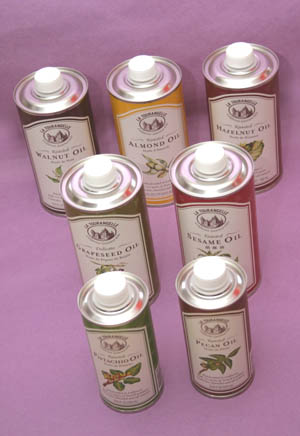
The La Tourangelle “family portrait.” Back row: Walnut, Almond and Hazelnut Oils. Middle row: Grapeseed and Sesame Oils. Front row: Pistachio and Pecan oils.
Back to Index
|
Read more about oils and related products:


|
Learn More About Different Types Of Oils:

|
Back to Index
FOR ADDITIONAL INFORMATION, special offers,
contests, opinion surveys, THE NIBBLE
back issues archive, product gift-finder, links to our favorite
food websites, and the ability to nominate YOUR favorite nibbles,
visit the home page of TheNibble.com.
Do you have friends who would enjoy THE NIBBLE™? Click here to send them an invitation to sign up for their own copy. |
ABOUT THE NIBBLE. THE NIBBLE™, Great Food Finds™, is an online magazine about specialty foods and the gourmet life. It is the only consumer publication and website that focuses on reviewing the best specialty foods and beverages, in every category. The magazine also covers tabletop items, gourmet housewares, and other areas of interest to people who love fine food.
© Copyright 2004-2025 Lifestyle Direct, Inc. All rights
reserved. All information contained herein is subject to change at any time
without notice. All details must be directly confirmed with manufacturers, service
establishments and other third parties. The material in this newsletter may not
be reproduced, distributed, transmitted, cached, or otherwise used, except with
the prior written permission of Lifestyle Direct, Inc.
|
|

|
 |















